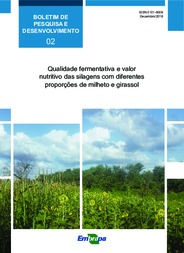Qualidade fermentativa e valor nutritivo das silagens com diferentes proporções de milheto e girassol.
Qualidade fermentativa e valor nutritivo das silagens com diferentes proporções de milheto e girassol.
Author(s): TONUCCI, R. G.; CHAVES, A. K. de L.; GUEDES, F. L.
Summary: Resumo - Objetivou-se avaliar a qualidade fermentativa e o valor nutritivo da silagem de milheto e girassol nas proporções de 100:0; 75:25; 50:50; 25:75 e 0:100, totalizando cinco tratamentos e três repetições. Foram utilizados minissilos de PVC e adotou-se delineamento experimental inteiramente casualizado. A abertura dos minissilos foi realizada aos 90 dias. Os dados foram submetidos à análise de variância e estimadas regressões, aplicadas no teste de Tukey (P<0,05) utilizando o programa do pacote estatístico do Statistical Analysis System - SAS® (SAS Institute, 2004). Verificou-se que apenas a recuperação de matéria seca e celulose apresentaram efeito quadrático com pontos de mínima de 93,1% e máxima 29,91%, respectivamente. A inclusão de girassol reduziu o teor de matéria seca e a produção de efluentes e pH das silagens. As perdas do nitrogênio total foram até 1,04% dentre os tratamentos. Na fração fibrosa, houve redução de fibra insolúvel em detergente neutro em 0,10 pontos percentuais a cada 1% de substituição e aumento dos teores de fibra insolúvel em detergente ácido e lignina em até 1,37% para todos os tratamentos. Os teores de proteína bruta; extrato etéreo e digestibilidade apresentaram efeito linear crescente, apresentando elevação de 0,029; 0,097 e 0,103 pontos percentuais por cada 1% de inclusão, respectivamente. Recomenda-se a proporção de até 50:50. [Fermentation quality and nutritive value of silages with different proportions of millet and sunflower]. Abstract - The objective of this study was to evaluate the fermentative quality and the nutritive value of millet and sunflower silage in proportions of 100:0; 75:25; 50:50; 25:75 and 0: 100, totaling five treatments and three replicates. PVC minisilos were used and a completely randomized design was used. A minisilos opening was performed at 90 days. Data were submitted to analysis of variance and estimated regressions, applied without Tukey's test (P <0.05), using the SAS® program. It was verified that only a recovery of dry matter and cellulose presented quadratic effect with points of minimum of 93.1% and maximum 29.91%, respectively. A reduced sunflower inclusion or dry matter content and an effluent production and pH of the silages. As total nitrogen losses so many up to 1.04% among treatments. In the fibrous fraction, there was a reduction of neutral detergent insoluble fiber by 0.10 percentage points for each 1% substitution and increase of the insoluble fiber content of acid detergent and lignin by up to 1.37% for all treatments. The crude protein contents; ethereal extract and digestibility presented linear increasing effect, presenting elevation of 0.029; 0.097 and 0.103 percentage points for each 1% inclusion, respectively. A ratio of up to 50:50 is recommended.
Publication year: 2018
Types of publication: Booklets
Unit: Embrapa Goats & Sheep
Observation
Some of Embrapa's publications are published as ePub files. To read them, use or download one of the following free software options to your computer or mobile device. Android: Google Play Books; IOS: iBooks; Windows and Linux: Calibre.
Access other publications
Access the Agricultural Research Database (BDPA) to consult Embrapa's full library collection and records.
Visit Embrapa Bookstore to purchase books and other publications sold by Embrapa.

